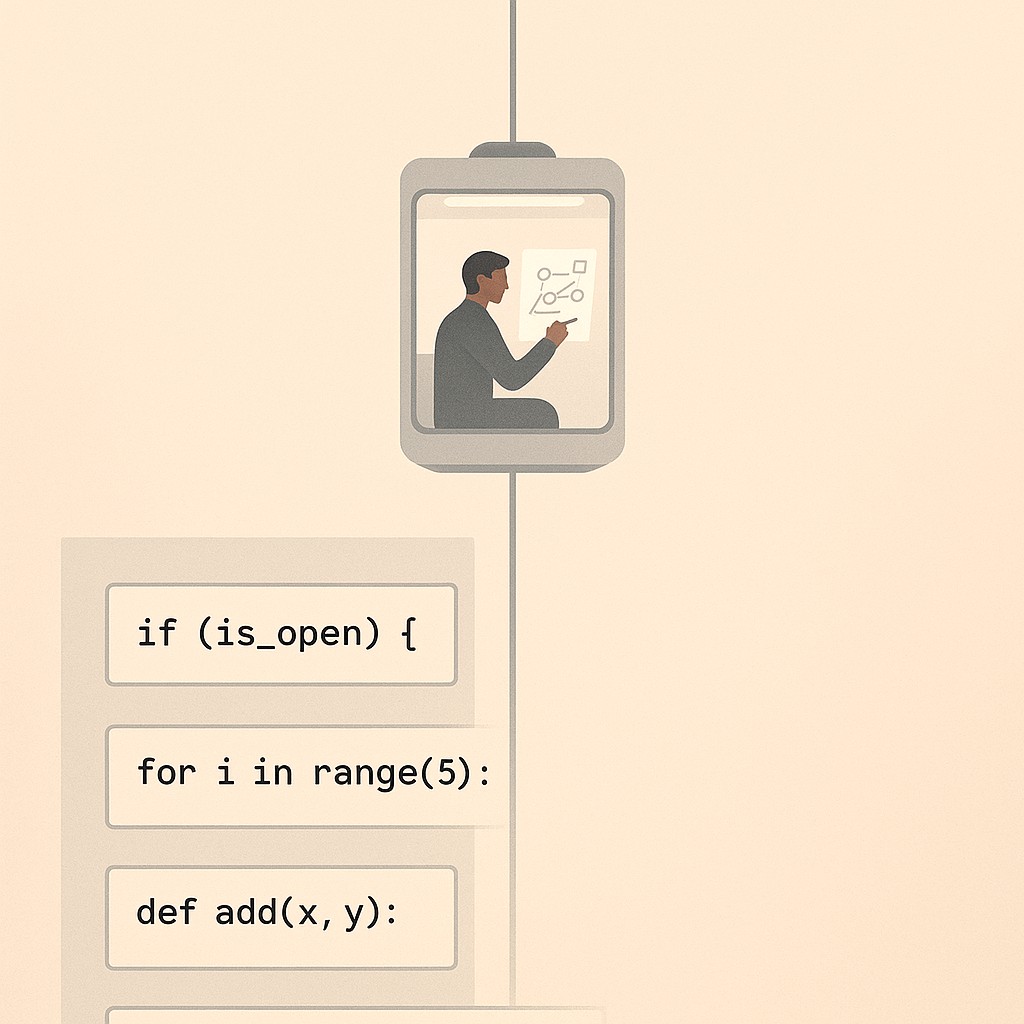Offload coding to AI and Raise Your Altitude: Build Systems, Not Boilerplate
Offload coding to AI and Raise Your Altitude: Build Systems, Not Boilerplate

Raising the Altitude: Offload Coding to AI and Build Higher
Last month, I shipped a production system that, a few years ago, would’ve taken weeks to get off the ground. The frontend, backend, plugins, database—even DevOps—became trivial when I chose to Offload coding to AI, which blew through the base layer work in hours with a first draft AI workflow. Instead of starting from an empty repo, I spent my energy orchestrating how everything fit together, sketching interfaces, nailing integrations, and troubleshooting where the seams weren’t perfect. The entire process felt less like drilling for code and more like directing a symphony where every part locked in just a little faster.
I know exactly why some folks hesitate to go this route. Throwing repeatable coding tasks to an AI can feel risky, like trading away hard-won skills you sweated to earn. The worry burns quietly. If you stop rolling up your sleeves for every detail, won’t those muscles start to fade?
But here’s the shift that made the difference for me—this isn’t about thinking less. It’s about thinking higher. When you treat AI as leverage, you raise the altitude of what you focus on. You start solving bigger, messier problems because you’re not trapped grinding out basics.
It’s like having an elevator. AI takes care of the floors you’ve already mastered, and you decide how many flights up you want to think. You can always take the stairs. Craft still matters. But the elevator’s there if you want to get moving.

And if you’re worried this is just about shortcuts or cheating, it’s not. The need for easier maintenance, optimized scalability, and independent automated deployment now drives over 75% of engineering choices, forcing us to keep pace as complexity scales higher and higher. The landscape changed. We need to change with it.
Climbing Higher: Why Career Growth Means Moving Past the Familiar
Every major shift in my career—military to mobile, mobile to cloud, now cloud to AI—meant letting go of comfort to grab something bigger. In the military, progress came from learning systems thinking under pressure, but leaving that meant walking away from a world where the “how” was well-defined. Moving into mobile, I had to drop the controller’s mindset to design for an unpredictable landscape, things like constant device churn and batteries dying at the worst moments. On cloud, the reset was harsh. Stacks changed, release cycles shrank, and suddenly my old migration scripts were ancient history.
Now, with AI in the mix, I’m learning to offload what I used to guard tightly—coding the details—to keep my hands free for the big stuff: connecting everything, tuning interfaces, driving outcomes across teams and customers. Each transition forced me to trade depth for scope, and I won’t lie, there’s always a moment where you think, am I leaving behind something important? But with every shift, the upside is real. You get access to new rooms of impact that just weren’t open before.
People like to say, “Don’t take the elevator, climb the stairs.” But if you look around, the building’s getting taller every year. With AI pulling the base level work, we aren’t just skipping the grind. We’re making it possible to reach problems that used to be out of reach. Sure, you can muscle your way up the steps. Craft matters. But when the structure doubles in height overnight, you need leverage, not just stubbornness.
I stopped measuring success by lines of code a while ago. Truth is, no one cares how tidy my REST endpoints are if the whole system doesn’t fit with the business goals. My value now is in how I orchestrate systems with AI to achieve fit. How does each component talk, what does the customer actually see, which pieces should live together and which need isolation? The thrill comes from watching everything link up, not from polishing loops or arrays. That’s the new altitude—and honestly, it feels better.
Six months ago, I remember spending weeks grinding out just a single frontend app. Perfecting the animations, chasing a dozen edge cases. Now, I spend those same weeks shepherding a whole system through production—API contracts, plugin handoffs, data flows, deployment pipelines. What changed is that my time horizon stretched, not because I worked faster, but because AI let me leap past all the repeatable setup. The old work is still there, but now it’s a floor I stand on, not a mountain to climb again.
That’s the new set of stairs—and they start higher up than ever.
Facing Doubts: What Atrophies, What Remains
Let’s name it—there are three big worries that come up when engineers start leaning on AI. Skill atrophy, tool reliability, and loss of craft identity. You’re not alone in thinking about these. I have too.
I’ll be honest. My raw coding has atrophied lately. I stopped doing scratch starts on greenfield projects. Some days, syntax slips away. What used to be muscle memory takes a second to recall, and sometimes I search for a function I once wrote blindfolded. It’s a bit jarring, I won’t lie. But over time, I realized that’s actually okay. These are the costs of moving up a level, and they’re mostly temporary if you need to dive back down.
But my impact? I’ve been able to scale engineering impact by roughly 10x. Giving up the daily repetition let me spend more time on architecture, integration, and figuring out where the system actually delivers value. The trade is real, and I’d make it again.
Reliability and identity are real questions too. Here’s how I handle it. I treat my AI coding assistant as a tool with guardrails. It gives me scaffolding and fast drafts, but I don’t let it run unsupervised. My judgment sets the boundaries—when it’s time to design a system, integrate tough dependencies, or evaluate and refactor AI code, that’s when I step in. That’s where experience matters, and my value shows up not in writing raw code but in knowing what should actually be built, and how it should all connect.
Random aside—I’ve got a half-baked habit from my military days. I used to keep a little notebook in my pocket, scribbling down grid coordinates next to what I was supposed to be doing. Sometimes the notes made no sense, a jumble of shorthand and arrows.
But every so often, flipping back through those messy pages, I’d spot patterns I missed in the moment. That skill—spotting the shape of the landscape, even if you don’t have every detail locked in—turned out to be weirdly useful when I moved to mobile and then cloud. Now, in AI, I still catch myself jotting diagrams that only I can read, connecting pieces across the stack. None of this is particularly efficient, but for whatever reason, those half-lost details help me track where the actual friction is. I haven’t figured out how to bring this habit fully into my AI workflow yet. Maybe it’s just a leftover comfort, maybe it’ll click into place one day.
Back in the first section, I talked about AI as the elevator. The stairs are still there—thinking, learning, craft. The trick is knowing when to switch between them.
Applying AI for Immediate Impact: Five Steps to Ship Smarter
Step 1. Start by scanning your process for repeatable patches where you can automate routine coding. Things like CRUD operations, REST endpoint scaffolds, boilerplate data models. These patterns are bread-and-butter for AI. If it’s something you’ve written more than twice, AI can crank it out without drama.
Step 2. Draw a clear line in your workflow. AI owns the straightforward, repetitive groundwork, and you step in where nuance, risk, or creative judgment show up. The divide isn’t about giving up control. It’s about playing to strengths. I’ll admit, early on I blurred this boundary and got burned chasing bugs AI wasn’t built to catch. Now, I intervene where integration gets messy or customer requirements go beyond surface-level code.
Step 3. Always put system design focus on the core first. Map how each layer talks—APIs, plugin touchpoints, data flows. Production is where all the seams get tested. I’ve learned that orchestrating how those AI-generated parts fit together up front saves headaches downstream. If you wait until later to stitch components, subtle incompatibilities always find a way to bite you.
Step 4. Layer in reliability right away. Wrap AI output with automated unit tests, configure CI/CD pipelines, and set up basic observability for AI systems: logging, traces, health checks. It’s not just cleanup or “extra” work. It’s how you tame the risks and put a harness around the unknowns AI spits out. This flips the script. Instead of trusting code blindly, you proof it with systems that alert you before tiny cracks become real failures.
Step 5. Never start from scratch when you don’t have to. Whether you need a CI/CD pipeline, database scaffold, or compliant Git repo from the jump, templates and golden paths let you kick off with a push or command—it’s done. I never start projects from scratch anymore, and that alone compresses iteration loops into hours, not days.
All told, when I Offload coding to AI, these steps keep me focused where it counts. Connecting systems, planning for scale, and driving customer outcomes. Offload the repeatable, take ownership of the orchestration, and you’ll find your altitude has shifted—fast.
Offload the repeatable writing too—use our app to spin up drafts for docs, specs, and updates, so you can focus on system decisions and shipping outcomes faster.
What Changes When You Commit: Anchoring Identity Above the Line
I’ll be direct. My edge isn’t the frameworks I learned last year or the syntax I keep remembering. It’s adaptability. When things shift, I get uncomfortable, lean into it, and learn new tools faster than most. That’s the only constant. Success, for me, is measured at the level of customer and business outcomes—by aligning AI work to outcomes, not lines of code, not perfectly crafted modules. It’s about getting systems to deliver value, even if the internals look different than they did five years ago. If you want longevity, anchor your identity above the line—where what you ship matters more than exactly how you wrote it.
Here’s my invitation. Offload repeatable coding, raise your altitude, and multiply your impact. Offloading repeatable tasks isn’t just theory—almost 90% of developers are reclaiming at least an hour each week, and 20% are saving a full working day. Use that time to steer bigger problems and own the outcomes. You’ll see how fast your whole career lifts when you do.
Enjoyed this post? For more insights on engineering leadership, mindful productivity, and navigating the modern workday, follow me on LinkedIn to stay inspired and join the conversation.
